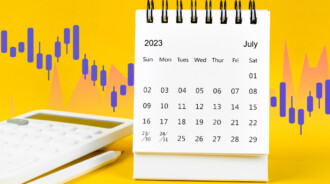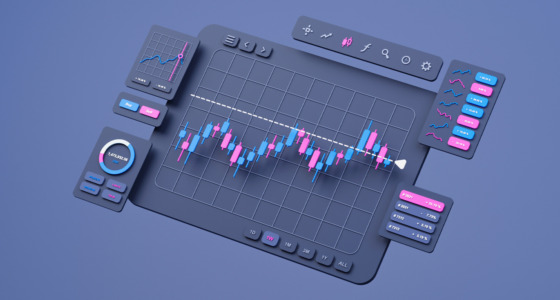

If you have the funds to put into financial markets, one of the first decisions you’ll make is how long you’ll keep your positions open. Whether it’s shares, cryptos, currencies, or anything else, you need to decide whether you’re more suited for long-term investing or short-term trading. This article will help you do it.
What is a long-term investment?
- Buying: Assets that you plan to hold (with no particular price point in mind)
- Selling: After a long period, for a gain
- Time horizon: Years
- Associated costs: Management fees and capital gains
- Analysis tools: Fundamental analysis, quarterly/annual reports, company announcements, news
Investing involves buying assets and holding them for long periods of time: for years and even decades. Your investment value increases only in rising markets — meaning if the asset value goes up over time. To pick assets with strong growth potential, investors evaluate them using economic, financial, qualitative, and quantitative factors and determine their intrinsic value.
For example, if you want to buy a stock of a certain company, you’ll need to look at the following indicators before investing:
- Dividend yield
- Dividend payout ratio (DPR)
- Earnings per share (EPS)
- Price to book value ratio (P/B)
- Price to earnings (P/E) ratio
- Price to earnings ratio to growth ratio (PEG)
Pros and cons of investing
Because the most common way to invest is to buy and hold stock, this section will focus on what’s good about stock investments:
- Relatively passive, no ongoing maintenance
- Grow with the economy
- Help stay ahead of inflation
- Two potential sources of income: price appreciation and dividends
- Require minimal knowledge of market mechanisms
What’s bad about investments:
- Require you to compete with institutional and professional investors
- Take a lot of time to pay off (although nothing is guaranteed)
- If you make a wrong guess, it’ll take years before you find out
- Stockholders of underperforming companies get paid last
What is short-term trading?
- Buying: Assets that you intend to sell at a specific, pre-determined price point
- Selling: Often with the intent to buy it back at a specific price
- Time horizon: Minutes, hours, days
- Associated costs: Depends on the size and frequency of transactions
- Analysis tools: Technical analysis, indicators, chart patterns, historical performance
Trading involves opening and closing positions within a relatively short period of time. Unlike investing, it offers an opportunity for returns even if assets lose value — this is done through short selling. Although it can be risky and controversial, it’s beneficial to have strategies for declining economies, too.
When you trade an asset, you are less interested in its intrinsic value and more interested in its chart performance. You’ll need to:
- Identify a trend on your chosen timeframe and search for patterns
- Draw support and resistance levels
- Establish entry and exit points
- Apply technical indicators to forecast future price movements
Pros and cons of trading
The benefits of trading are:
- Lower capital requirements
- Everything happens at a rapid pace
- Potentially brings higher returns
- Opportunity to leverage your positions and increase their size
- Ability to take advantage of short-term volatility and downward trends
The negative aspects you should be aware of include:
- Trading has to become a part of your daily or weekly schedule
- Requires complex price, trend, and chart assessments
- Riskier, may cause substantial losses with leverage
- Involves more fees due to a high frequency of transactions
How does short-term investing work?
Short-term investments work best for those who wish to make a profit in the short term. These types of investments can be sold or converted into cash within a short timeframe, usually in 1-3 months. Very rarely are they kept for up to 3 years. Day trading can also be categorized as a short-term investment, with a trader getting one day’s worth of profit.
The money is then used for another potential investment, such as another short-term investment. The main goal of this type of investment is to protect the capital while generating returns for it. It is not made to be kept and selling it for a higher percentage will help increase the portfolio.

How does long-term investing work?
Long-term investments are kept for a much longer time (usually more than 5 years). This can include bonds, stocks, real estate, or even currencies that will change their value over time.
Long-term investments involve a higher risk, especially considering the unpredictability of the market. They rely on patience but can potentially result in more profit if the investment was chosen carefully. Long-term investments work best for those who do not have the time or patience to check their investments very often as it is with short-term trading.
Short-term vs. long-term investing and their characteristics
Short-term and long-term investments are both very different and may have different expectations. This is why you need to be aware of the characteristics so that you can make the right choice.
When it comes to long-term investments, you may enjoy the following benefits and characteristics:
· They have little to no management as compared to short-term investments
· They are less expensive, as you do not have to pay as much in commissions and exchange
· The potential for profit is very high, provided you purchase a good long-term investment
· Lower risks, especially when it comes to stocks and real estate, as the market is continuously on the rise
· Data is very easy to access, allowing you to make a smart investment
· They are recession-proof, either because they are fixed deposits or because they are bound to recover once the economy is back in balance
· You’ll sleep better at night, knowing you do not have to constantly check on your assets
That being said, short-term investments also have several characteristics that make them a good choice. These can include:
· They allow you to diversify your portfolio with different assets, mitigating the risk
· They are usually less expensive compared to long-term investments
· The chances for profit are higher, as you will not likely fall victim to a stock market fall
· They offer the flexibility of payment, as you don’t have to wait for specific security to mature
· Transactions are lower, making them less risky
Both investment types are great, depending on your investment style. You just need to determine when you want to cash in the money. If you plan to cash in on the money soon, short-term investments are a good option. On the other hand, if you want to save for retirement or something similar, long-term investments may be better.
Investing vs. Trading personalities
Both investing and trading require emotional discipline. The fear of loss or excitement of gains should not cloud your judgment or force you into rushed decisions. In both cases, you’ll need to respect the time horizons you have set up in advance.
That said, the decision-making process for long-term investments is vastly different from the one for day trades. It requires not only different skills but also different mental and emotional capabilities.
To do well as an investor, you need to master the art of stepping back. Every decision a company makes and every economic event may impact your investment. But as long as you stand by your fundamental assessment of the asset, you’ll have to accept market downturns and wait.
Trading requires more attention throughout the day, especially if you want to find opportunities to make small but frequent returns. So, to be a good trader, you need to be more reactive, while also keeping greed, hope, and fear at bay. It is about a delicate balance of being quick and decisive as well as wise and patient.
What is more suitable for you?
It’s easy to get caught up with what you’re supposed to do. But when you decide how to split your funds between trading and investing, focus on your goals. Ask yourself what you’re hoping to achieve and how much time, funds, and effort you want to put into it.
If you want to build capital over a long period of time and have a “set it and forget it” mindset, investing will probably suit you more. Start building a low- and medium-level risk investment portfolio and don’t expect quick returns. If you’re after quick liquidity, you might make a good trader. Remember that it involves higher risk, so keep your trades small at first.










